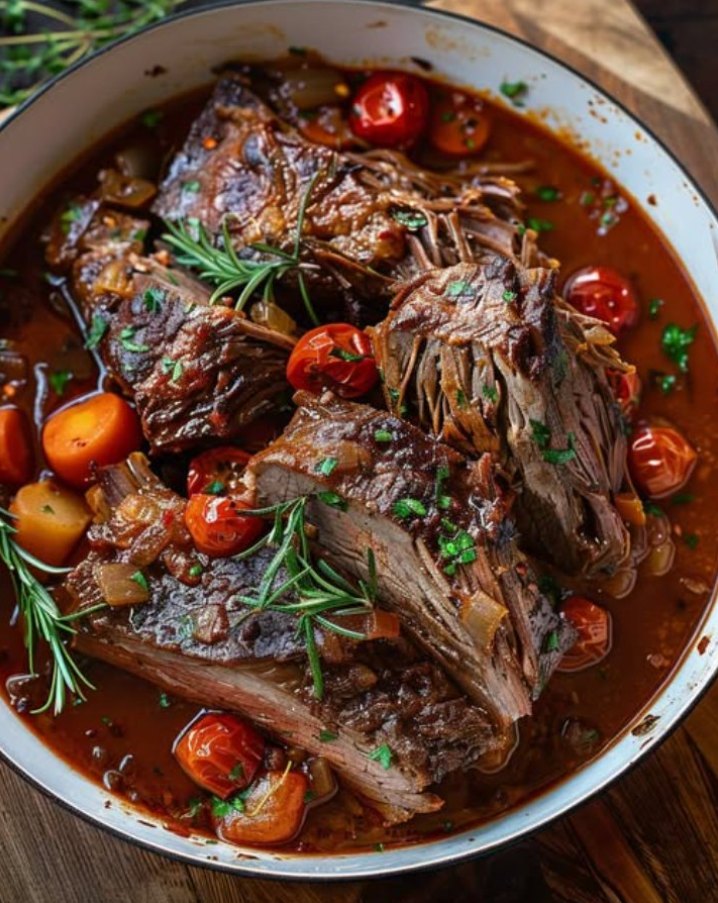Why Italian Beef Straccato is a Game-Changer for Family Dinners
There’s something magical about slow-cooked dishes that make your kitchen smell like love and warmth. One day, while trying to impress my family with a twist on classic comfort food, I stumbled upon Italian Beef Straccato. This dish combines tender shredded beef with rich, herby tomato sauce, making it a hug-in-a-bowl kind of meal. The best part? It’s simple enough for a weeknight but fancy enough for special occasions. Let me tell you why this recipe has become my go-to when I want to serve something hearty yet easy to prepare.
The Story Behind Italian Beef Straccato
Italian Beef Straccato might sound exotic, but its roots are humble. The word “straccato” means shredded in Italian, which perfectly describes what happens to the beef during cooking. Traditionally, similar recipes were made by Italian families looking for ways to turn tougher cuts of meat into meltingly tender meals. Back then, wine was often used as part of the braising liquid, but modern versions skip alcohol entirely, focusing instead on bold flavors from herbs, vegetables, and tomatoes.
When I first tried it, I was hosting a dinner party where some guests preferred halal options. That’s when I discovered how versatile this dish could be—halal-friendly, packed with flavor, and universally loved!
Why You’ll Fall in Love With This Recipe
If you’re searching for a crowd-pleaser, look no further. Here’s why Italian Beef Straccato deserves a spot in your recipe rotation:
- Flavor Explosion: The combination of garlic, herbs, and tomatoes creates a savory sauce that clings beautifully to every strand of shredded beef.
- Effortless Cooking: Once everything goes into the oven, all you need to do is sit back and let the magic happen.
- Versatility: Serve it with pasta, mashed potatoes, or even polenta—it works wonders with almost any side.
Perfect Occasions for Italian Beef Straccato
This dish shines at gatherings where everyone craves something cozy yet impressive. It’s perfect for Sunday dinners, holiday feasts, or casual get-togethers. Plus, leftovers reheat beautifully, so it doubles as tomorrow’s lunch hero. Trust me; your coworkers will thank you!
Ingredients List
- 1.5 kg of beef roast
- 1 onion, chopped
- 2 carrots, diced
- 2 celery stalks, sliced
- 4 garlic cloves, minced
- 1 can (400g) crushed tomatoes
- 375 ml beef broth
- 2 tbsp tomato paste
- 1 tbsp balsamic vinegar
- 2 bay leaves
- 1 tsp dried oregano
- 1 tsp dried thyme
- 2 tbsp olive oil
- Salt and pepper to taste
Substitution Options
No worries if you’re missing an ingredient or two. Try these swaps:
- Beef Roast: Substitute chuck roast or brisket for equally tender results.
- Balsamic Vinegar: Use red wine vinegar or apple cider vinegar if needed.
- Fresh Herbs: Swap dried herbs for fresh ones—just double the quantity.
Step 1: Preparing Your Ingredients
Start by gathering all your ingredients. Chopping veggies may seem tedious, but trust me, it’s worth it. Imagine the vibrant colors—the deep red of tomatoes, the bright orange of carrots, and the earthy green of celery—all coming together to create a symphony of flavors. Dice them evenly to ensure they cook uniformly. Season the beef generously with salt and pepper because seasoning is key to unlocking those rich flavors.
Step 2: Browning the Beef
Heat olive oil in a large pot over medium-high heat. Carefully place the seasoned beef inside and sear until golden brown on all sides. Don’t rush this step—it builds a flavorful crust that locks in juices. As the beef browns, your kitchen will fill with mouthwatering aromas. Remove the beef and set aside while you tackle the next layer of flavor.
Step 3: Sautéing Vegetables
In the same pot, toss in the onions, carrots, celery, and garlic. Stir occasionally until softened. Watch how the vegetables transform from raw to caramelized perfection, releasing their natural sweetness. Pro tip: Keep stirring to prevent burning, especially near the edges of the pot.
Step 4: Building the Sauce
Add tomato paste and stir for 2 minutes—it intensifies the tomato flavor. Pour in the beef broth, scraping up any browned bits stuck to the bottom. These bits are pure gold, adding depth to the sauce. Add crushed tomatoes, balsamic vinegar, bay leaves, oregano, and thyme. Mix well before returning the beef to the pot.
Step 5: Slow-Cooking Magic
Cover the pot and pop it into the preheated oven at 160°C (320°F). Let it cook low and slow for 3 hours. During this time, the beef becomes so tender it practically falls apart under the slightest touch. When done, shred the beef using two forks and mix it back into the sauce.
Chef’s Tip
To elevate your Italian Beef Straccato, finish it with a drizzle of extra virgin olive oil just before serving. It adds a glossy sheen and enhances the overall richness.
Timing Breakdown
- Preparation Time: 20 minutes
- Cooking Time: 3 hours
- Total Time: 3 hours 20 minutes
Extra Info
Did you know that slow-cooking tough cuts of meat breaks down collagen, turning it into gelatin? That’s what makes the beef in this dish so melt-in-your-mouth delicious!
Necessary Equipment
You’ll need a heavy-duty pot or Dutch oven, tongs for handling hot ingredients, and a couple of forks for shredding the beef.
Storage Tips
Leftovers? Lucky you! Store cooled Italian Beef Straccato in an airtight container in the fridge for up to 3 days. Reheat gently on the stovetop or microwave.
For longer storage, freeze portions in freezer-safe bags. Label them with the date so you don’t lose track. Thaw overnight in the fridge before reheating.
Avoid freezing the dish multiple times, as it can affect texture and flavor. Always cool completely before refrigerating or freezing.
Tips and Advice
Use a meat thermometer to check doneness—internal temperature should reach 90°C (195°F). Also, resist the urge to peek too often during cooking; maintaining consistent heat ensures even tenderness.
Presentation Ideas
Garnish with freshly chopped parsley for a pop of color. Serve atop creamy mashed potatoes or al dente pasta for a restaurant-worthy presentation.
Healthier Alternatives
Here are six variations to lighten things up:
- Leaner Cut: Use sirloin roast instead of fatty cuts.
- Low-Sodium Broth: Opt for reduced-sodium broth to cut down on salt.
- Zucchini Noodles: Swap carb-heavy sides for spiralized zucchini.
- Vegan Version: Replace beef with mushrooms for a plant-based option.
- Less Oil: Reduce olive oil to 1 tablespoon.
- No Sugar Tomato Paste: Choose sugar-free varieties for fewer carbs.
Mistake 1: Skipping the Searing Step
Some people skip browning the beef thinking it saves time, but this step is crucial for developing flavor. Without it, the dish lacks depth. Take the extra few minutes—it’s worth it.
Mistake 2: Overcrowding the Pot
When sautéing veggies, overcrowding leads to steaming rather than caramelizing. Cook in batches if necessary to achieve that desirable golden hue.
Mistake 3: Rushing the Cooking Process
Patience is key here. Turning up the heat won’t speed things along—it’ll only result in tough meat. Stick to the recommended temperature and timing.
FAQ
Can I make this dish ahead?
Absolutely! In fact, flavors deepen after resting. Make it a day in advance, then reheat before serving.
Is this recipe gluten-free?
Yes, provided you use gluten-free broth and ensure no cross-contamination occurs.
What sides pair best with this dish?
Pasta, mashed potatoes, rice, or crusty bread work wonderfully. For lighter options, try roasted vegetables or a crisp salad.
How can I adjust spice levels?
Add red pepper flakes for heat or omit them entirely if you prefer milder flavors.
Can I use frozen vegetables?
Fresh is ideal, but frozen works in a pinch. Just thaw and pat dry before adding.
What type of beef is best?
Chuck roast or brisket yields the most tender results due to their fat content.
How long does it keep in the freezer?
Up to 3 months if stored properly in airtight containers.
Do I have to use balsamic vinegar?
No, red wine vinegar or lemon juice can substitute, though the flavor profile will shift slightly.
Can kids enjoy this dish?
Definitely! Its mild yet flavorful nature appeals to both adults and children alike.
Should I trim excess fat from the beef?
Trimming is optional. Fat adds moisture during cooking, but removing it beforehand reduces calories.
Final Thoughts
Italian Beef Straccato is more than just a recipe—it’s a celebration of simplicity, flavor, and tradition. Whether you’re feeding your family or hosting friends, this dish promises satisfaction without stress. So grab your apron, gather your ingredients, and let the aroma of slow-cooked goodness bring joy to your table. Happy cooking!

